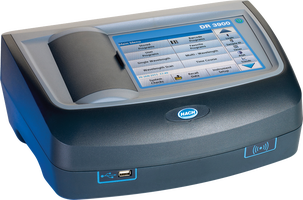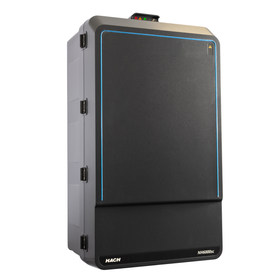-
English (US)
Choose your country or region:
Europe
Asia - Australasia
Middle East - Africa

At Hach®, we embrace the challenge to continuously improve wastewater treatment monitoring equipment and processes to help your industrial plant stay in compliance and ensure instrument reliability. Best of all, Hach solutions will help control costs while operating at the highest possible levels of health and safety.
Airports
Beverage
Chemical
Food
Manufacturing
Maritime
Metals and Mining
Petrochemical
Plating
Power Generation
Pulp and Paper

See which of our spectrophotometers is best for your specific application and methods.


We spent years innovating the best-in-class ammonia analyzer (you know as Amtax) to function with the ease you want and the accuracy you need. Introducing the lower maintenance NH6000sc with a lightweight, integrated FX6 filtration system option.

Accurate, easy and intuitive, the AS950 simplifies your sampling process with a large, full-color display, USB upload and download capabilities, and the ability to copy programs sampler to sampler to save time on tedious programing.

Take the guesswork out of BOD measurement with the HQ430D. HQD® meters connect with smart IntelliCAL® electrodes that automatically recognize the testing parameter, calibration history, and method settings to minimize errors and setup time.

The Solitax ts-line sc immersion probes provide accurate, color-independent suspended solids and turbidity measurements. This system’s reliable performance and full data communication capability help improve process control and reduce treatment cost.
Learn which measurements are critical throughout the wastewater treatment process.
![]()
Sensor and/or
Analyzer
+
![]()
Controller
+
![]()
Mobile Sensor
Management
Software
=
Your
Solution
Many plant managers have concerns about trusting their data. Hach customers typically trust their data after just three short weeks of adopting Claros process management solutions.
Mobile Sensor Management allows you to view your measurements and instrument status—anytime, anywhere on any web-enabled device. The included Prognosys Predictive Diagnostic Software monitors the instrument’s internal components and tracking service requirements. Then, Mobile Sensor Management alerts you to upcoming maintenance tasks or identifies immediate issues requiring attention. It also provides simple maintenance instructions in the palm of your hand to give operators and plant managers the confidence that the maintenance is being done correctly.
With Mobile Sensor Management, you can avoid unexpected downtime and have confidence in your water quality measurements.
Data security is our priority. Hach is committed to protecting the integrity of your data, with comprehensive data security processes, continual evaluation and best-in-class partners such as Microsoft Azure to ensure data sovereignty and to eliminate opportunities for external intrusion. From data generation to transmission, storage and retrieval, Hach is committed to keeping your data safe, now and into the future
A variety of parameters are used in industrial wastewater pre-treatment, biological wastewater monitoring and receiving water discharge. Browse below to learn more about why these parameters matter. Or choose Shop Now to see solutions.
Measuring alkalinity in water will inform its capacity to neutralize acids or absorb hydrogen ions. A slightly alkaline pH is important for effective biological treatment. The process of nitrification destroys alkalinity, which can result in a drop in pH, which will inhibit bacteria. Having visibility into your alkalinity will help avoid permit violations for ammonia and or pH.
Monitor conversion of ammonia and organic nitrogen forms to nitrite and nitrate during the WW treatment process. Provides information on process conditions in biological treatment stages. At high concentrations and pH, ammonia can be toxic to sludge digestion microbes.
Automatic samplers are required to pull samples from different locations within a process so that laboratory tests can be performed. Samples may be collected as a composite or discreetly, depending on site and permit requirements.
BOD5 and CBOD indicate a relative measure of “food” available, the degree of stabilization of the wastewater and estimate the effect of the effluent on the receiving water body. Used for plant loading/design, discharge rate for industrial facilities and EPA NPDES reporting. Many plants use COD or TOC as an early estimate. Used to calculate % removal.
Used as a correlative/early indicator of BOD levels. Some NPDES permits include COD as a surrogate for BOD; however, BOD is the standard reportable parameter for oxygen demand in wastewater. COD provides a measure of organic “food” available to biological treatment steps and to estimate the effect of discharge to receiving water.
Chlorine is added to kill pathogens and reduce odor. Measuring chlorine will help ensure that your wastewater is properly disinfected by removing pathogens as well as satisfy regulations that require the removal of excess chlorine before discharge to surface waters.
Color can be an indicator of turbidity or suspended matter. The removal of this matter can be gauged by measuring color, which can indicate if the water quality is suitable for discharge.
Measuring conductivity is a common method for determining the metal concentration in wastewater. Removal of these metals prevents environmental concerns. Conductivity is also an indicator of dissolved sodium which can assess stages of the treatment process that cause changes in conductivity.
To stay alive, the organisms that breakdown organic matter rely on oxygen. When there is not dissolved oxygen present, these organisms will die. On the other hand, too much oxygen could signify that your wastewater treatment process is wasting energy. Measuring dissolved oxygen levels can help dial in the right amount of aeration.
Flow measurement is crucial to a plant to know the volume and rate of the liquid passing through each process. These measurements are used to calculate loading and concentration factors for processing.
Nitrate is indicative of the stage of conversion of ammonia and organic nitrogen forms to nitrate by the aerobic biological treatment steps (nitrification).
Determine if acidification has occurred during the effluent pre-treatment stage of your treatment process by monitoring pH and alkalinity. Making adjustments to pH and alkalinity balances organic acid.
Indicates the amount of carbon nutrients required to feed and keep healthy the microorganisms in the process aeration basin. This parameter gives an indication of efficiency of the anaerobic digester process.
Oxidation Reduction Potential is the ability for a solution to accept or lose electrons and therefore be “reduced.” ORP can help determine whether activated sludge zones are anaerobic or anoxic to enhance biological nutrient removal. They are best applied as a trending tool.
Maintain proper (narrow) pH range for optimal biological processes—especially nitrification. pH and temperature can indicate plant upsets by industrial discharges or the development of anaerobic conditions within the plant. It’s also an important parameter to assess methane formation and avoiding ammonia toxicity in sludge digesters.
Phosphate is removed via biological nutrient removal processes and/or chemical precipitation. Reactive (ortho) phosphate is the phosphorus form that is most available to biological species.
Having a clear measurement of sludge helps monitor sludge levels in the aeration tank, where sludge is mixed with air to breakdown organic matter. Monitoring sludge levels can indicate sludge buildup, process and chemical efficiency and sludge settleability.
Measuring Spectral Absorption Coefficient is excellently suited to use as a regulation parameter for an ozone system.
Total of ammonia, nitrate, nitrite and organic nitrogen forms.
TOC levels in water impact treatment and re-use decisions. With data on TOC levels, water managers can make the most efficient and cost-effective decisions for treatment and reuse of important water supplies.
Phosphorus effluent concentrations are often controlled by discharge permits to limit the addition of nutrients to the receiving body. Total phosphorus may be removed either biologically or chemically. It includes ortho-, poly- and organic phosphorus.
TSS is the most commonly measured and regulated parameter on NPDES permits. Used to measure mixed liquor suspended solids concentration, return activated sludge/waste activated sludge concentration, influent suspended solids concentration, effluent suspended solids concentration and % removal.
COD is the sum parameter that provides the most reliable and timely information about the oxygen-depleting effects of organic pollutants in wastewater. COD also supplies an estimate of the effect of your plant’s effluent on the receiving body.
Turbidity is a surrogate measurement for solids concentration. This parameter often is used to indicate solids carry-over from secondary clarifiers.
Contact us for tech support, service, sales, or to get a quote.